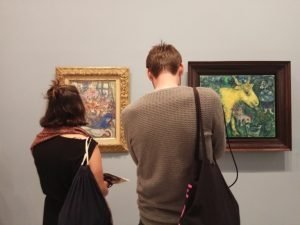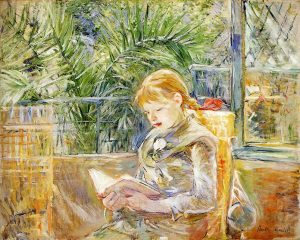Paul Signac – One of the Founders of Neo-Impressionism
Paul Signac (November 11, 1863 – August 15, 1935) together with Seurat were the pioneers of neoimpressionism (pointillism). This was a new art movement that evolved from impressionism.
Both Seurat and Signac were inspired by a scientific optical theory, that color pigments do not need to be mixed together on the palette or directly on canvas. Instead, by placing tiny dots side by side, the mixing of the colors will naturally occur at a suitable distance, in the eye of the observer. This has been termed “The Optical Mixture”.

Young Signac & the Impressionists
Paul Signac was born into a comfortable middle-class family in Paris in the late-19th century. Significantly, the family relocated early in his life to the Montmartre, which was then the thriving artistic epicenter of Europe.
In his youth, Signac was drawn to the work of the Impressionists, then still very revolutionary in the art world. His parents being very liberal minded, encouraged young Signac to attend the impressionist exhibitions.
When Signac’s father died, the family moved to a new Parisian neighborhood called Asnières. However Signac moved back to Montmartre and rented a small room there. He forged connections with other artists, writers & musicians.
In one particular exhibition, Signac saw the paintings of Claude Monet. He both admired Monet’s Impressionist style and plein-air painting methods (painting outdoors and not in a studio). It was at this stage that Signac decided to become a painter.
Aside from receiving some fairly basic training in painting, Signac was mainly self-taught. In his early paintings, you can see the influence of the impressionists. He paints with bright colors and paints outdoors (plein-air painting).

Neoimpressionism & Seurat
When Signac’s meets the painter Georges-Pierre Seurat, they become firm friends and both share a fascination with the color theory of Michel-Eugene Chevreul.
This theory states that by juxtaposing complementary colors one can produce the impression of another color. This scientific theory becomes the foundation for their paintings and for the neo-impressionism (pointillism) art movement.
Both Seurat and Signac become the founders of neo-impressionism and pointillism art movements. They both paint by applying small dabs (or dots) of intense color closely together on the canvas, using contrasting shades that appeared to merge and shimmer when viewed from a distance.

By December of 1885, Signac and Seurat and others solidify their unique neo-impressionism style. Together they are invited to display their paintings in the eighth and final impressionist exhibition together with Degas, Cassatt, Gauguin, Monet, Renoir, Pissarro and others.
Signac and Van Gogh’s Friendship
Signac meets Vincent van Gogh in Paris in 1886. The two painters admire each others work and start painting together. Van Gogh likes the loose brushwork of Signac. While Van Gogh is living in Arles in 1889, Signac pays a visit and teaches Van Gogh how to paint with the neo-impressionism style.

Although Van-Gogh does not adopt neoimpressionism, he does experiment a few times which is evident in a few self portraits that he paints.
Signac Marries & Moves to Southern France
In November of 1892, Signac marries his longtime companion, Berthe Roblès (a cousin of Camille Pissarro). A few years later, they leave Paris for Saint Tropez in the Côte d’Azur .
In Saint-Tropez, Signac builds a large painting studio. It is during this period that he paints some of his most colorful and famous neo-impressionism paintings. The subject matters often features boats, beaches and seascapes.

Paul Signac’s Later Years
As an older artist, Signac guides younger painters who are beginning their careers. He is a friend and mentor to Henri Matisse, who often visits him in Saint-Tropez.
Signac dies on August 15, 1935 at the age of 71. His grave is located in the famous Paris cemetery, Pere Lachaise. He left behind an enormous body of work that are now owned by major museums, galleries and private art collections all over the world.

Museums in France
When in Paris, go the beautiful Musee D’Orsay. This stunning museum houses a lovely collection of Paul Signac’s neo-impressionism paintings.
If you are traveling to the Cote d’Azur, pop into Saint Tropez and visit the Musee de l’Annonciade. This small but exquisite art museum exhibits impressionism & post-impressionism artworks from the 19th and 20th centuries. Here you will see paintings of artists who lived and painted Southern France. This includes artworks of Signac, Bonnard, Marquet, Matisse, Vlaminck, Delacroix & many others. For more information, press here.








Let's hear your comments!